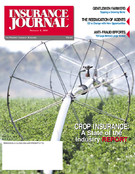In fact, that’s much of the problem with many a bankrupt rancher, he’s got beef! If he sells it, he loses money and if he keeps it, he loses money. It’s the reality of hard economic times in agriculture over the past 20 years that has forced many family managed farms and ranches to ruin. Unfortunately, many of the benefits from the country’s most recent prosperity never made it to the small family farm.
In 1920, our nation was supported by 6,448,343 farmers and ranchers. However, that number has dropped three-fold to less than 2 million today. The traditional pool of new entrants into farming—white males in their 20s growing up on family farms—is shrinking, from about 700,000 in 1990 to approximately 365,000 today. This shrinkage is attributable both to the decline in the number of farms and to the fact that farm families have fewer children than in the past.
In addition, like their non-farm counterparts, the majority of U.S. farm households now have two breadwinners in the household. Off-farm income has become a critical supplement and buffer to the swings in income common for most small farm and ranching operations. Bottom line, the farm and ranching sector has been a decreasing factor in our economy over the past two decades.
FRO premiums tell the story
This national trend has been true in Texas, as well. Yet, a corresponding trend in the total amount of FRO premiums written in the state has not been realized. In 1999, companies writing this line of business showed an increase over previous years with $60,606,461 reported earned premiums, as reported by the Texas Department of Insurance.
So what’s going on here? Obviously the entire 167,600,000 areas of land in Texas didn’t all get eaten up by up by urban sprawl. Otherwise, one would expect FRO premiums to reflect the sector to which it is closely tied.
Like all business sectors, agriculture is quickly changing. In previous years, the United States Department of Agriculture used very simple farm typology to categorize the family farm in America. Family farms excluded farms organized as non-family corporations or cooperatives, as well as farms with hired managers. It was simply defined as a closely held (legally controlled) farm by its operator and the operator’s household.
A “large family farm” or “commercial farm”, was the term frequently used for operations in excess of $50,000 in sales. “Noncommercial” or “small family farms” had sales less than $50,000.
However, today small family owned farms are officially classified as either Limited-Resource Farms, Retirement Farms, Farming Occupation Farms, or Residential/Lifestyle Farms.
Limited-Resource Farms are just that—operations with gross sales of less than $100,000, with assets less than $150,000, and a total operator household income less than $20,000. Retirement Farms are small farms whose operators report they are retired. Farming Operation Farms are farms whose operators report farming as their major occupation.
That leaves Residential/Lifestyle Farms. While specific hard numbers are difficult to come by, in Texas, Farms and Ranches with 1 to 99 acres consisted of 42.8 percent of all farm and ranching operations in 1977. This is the only segment of farm and ranches categorized by acreage to have grown since 1992.
In addition, operations classified as “family” in Texas have actually increased since 1992 to over 175,299 in 1997 out of a total number of 227,000 farm and ranches in the state. This gives strong evidence to the fact, that while the number of “traditional” family farm and ranches is on the decline, the number of Residential/Lifestyle farms is on the up swing.
Opportunity presents itself
Finding emerging markets and identifying their insurance needs, has always been the strength of the independent agent. Hence, targeting the Residential/Lifestyle or Hobby Farm is a natural. With over $93 billion of assets down on the farm in Texas, opportunity awaits any agency.
In addition, it must be remembered that a Hobby Farm is just that, a hobby. It is not the primary source of income to the household. Hence, the potential opportunity to cross sell is even greater. Owning a farm or ranch is not a poor man’s hobby. Most hobby farm owners typically have other significant personal and business assets that need insurance.
Many an agent has built his or her book of business by getting their “foot-in-the-door” by securing coverage for the hobby first. The story is a common one traded at many conventions. After writing the customers jet ski, boat, motor home, or seasonal dwelling, the agent was later able to secure the customer’s entire business. A hobby farm isn’t any different.
But don’t make the classic mistake of underestimating the exposures associated with a hobby farm. An uncovered loss usually loses a customer’s entire account, but also can create a sticky E&O situation. Hobby farms have many of the same exposures as Farming Occupation farms. Remember that they are still farms after all.
HOB vs. FRO
While a homeowners form may be cheaper—and sometimes appropriate—agents need to be very careful before recommending this type of coverage. The FRO-B may appear on the surface to be no different than a HOB, however the FRO does provide specific coverages for farming operations and greater flexibility with many special endorsements.
When assessing a hobby farm exposure, consider the need for inland marine coverages on equipment. It’s probably not the typical mower purchased at the local hardware store in the shed out back. Outbuildings also present their own challenges when insuring them. Barns filled with hay and various chemical fertilizers not found in suburbia are common.
Horses are also often associated with many hobby farms and ranches. It’s not Fido biting the mailman that’s your primary concern here (although Fido can still bite a mailman on a rural route, too). Equine liability issues result in an entirely different set of problems that must be addressed and covered correctly.
Also, not all FRO forms are created equally. Up until Jan. 1, 1998, Texas mandated a standard FRO form. However, the FRO form has been deregulated since then and companies are free to introduce their own forms, though most have stuck with the old mandated form or shifted to ISO’s form.
So, while the hobby farm can be a great opportunity, don’t leave your insured alone and “out to pasture”. Make sure you properly assess the exposure before selling any coverage. This will allow you and your agency to capitalize on a growing market segment.
Diana Trachier is the farm & ranch manager for South & Western General Agency based in Addison. She has spent 12 of her 16 years in the insurance business specializing on farm risks.
Topics Texas Agribusiness
Was this article valuable?
Here are more articles you may enjoy.


 Alliant Latest to Sue Howden US Over Alleged ‘Smash-and-Grab’ Poaching
Alliant Latest to Sue Howden US Over Alleged ‘Smash-and-Grab’ Poaching  Experian: AI Agents Could Overtake Human Error as Major Cause of Data Breaches
Experian: AI Agents Could Overtake Human Error as Major Cause of Data Breaches  DoorDash, Uber Cost Drivers $550 Million in Tips, NYC Says
DoorDash, Uber Cost Drivers $550 Million in Tips, NYC Says  Trump Nominates WeatherTech’s MacNeil to Be FTC Commissioner
Trump Nominates WeatherTech’s MacNeil to Be FTC Commissioner 


